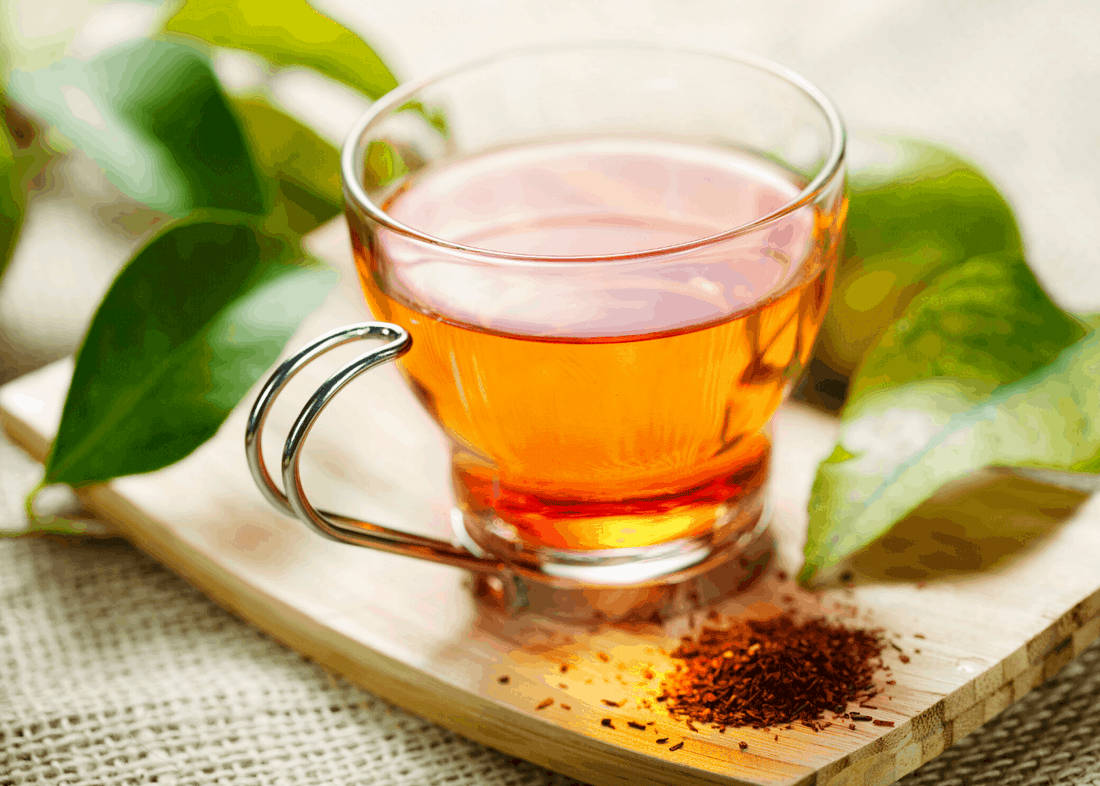
As Eastern practices continue to influence the West, green tea has gained a strong foothold in our tea culture. And in more recent years, tea antioxidants have become a popular ingredient in skincare, with many of the same benefits as ingesting the tea.
Green tea and black tea come from the same plant, Camellia sinesis, but the green tea is not fermented before steaming and drying. For this reason, the polyphenolic content of green tea is much higher than black tea. Polyphenols serve as antioxidants to fight free radical damage from environmental stresses, as well as to reduce inflammation. Epigallocatechin gallate or EGCG, is a type of polyphenol found in Green Tea known as a catechin and is the most abundant catechin in Green Tea.

Green Tea Polyphenols as Antioxidants
Green Rooibos - The New Rival to Green Tea
Like green tea, Green Rooibos Tea comes from the unfermented leaves of Aspalathus linearis, an herb native to South Africa and has far greater antioxidant potential than red (fermented) rooibos, also known as redbush. Rooibos is equally rich in polyphenols, with the main flavonoid, Aspalathin, being unique to this herb.
Recent studies carried out at the Nelson Mandela Institute in South Africa show that the antioxidant potential of Green Rooibos Tea is comparable to green tea, making this herb a new rival to green tea in skincare.
Botanical extracts are becoming increasingly popular in skincare as consumers favour natural skincare. What's more, plant extracts contain a variety of antioxidant compounds that work together synergistically to fight oxidative stress, offering better protection than single antioxidant compounds, like Vitamin C.
But the advantage of green tea polyphenols does not stop there. There is something unique about green tea antioxidants.

Free Radicals Bombarding Cells
Antioxidants Scavenge Free Radicals
Most of us understand that antioxidants scavenge free radicals. Some free radicals in the body are beneficial to trigger cellular defence mechanisms but an excess of free radicals will lead to oxidative stress, causing cell damage and ultimately cell death. And over production of these Reactive Oxygen Species is associated with skin ageing. So, we are all reaching for our antioxidant serums in the morning, with the premise of environmental protection and youth preservation.
The Cell's Intrinsic Antioxidant Pathway
What is often overlooked is that our cells have their own elaborate antioxidant network which naturally defends themselves against oxidative stress. This complex cellular system comprises of antioxidant enzymes, like catalase and superoxide dismutase, low molecular weight antioxidant molecules and an intricate signalling system, all aimed at maintaining redox homeostasis.

London Public Transport - Black Cab & Bus
To use an analogy, let’s take the road and rail network in London and think of your cells natural defences being the public transport links. So, the buses, taxis, ubers and tube represent your antioxidant enzymes and so on. And the cars and non-public transport are the free radicals. Antioxidants introduced by diet or skincare can either work with or against these cellular mechanisms, or the public transport links, to enhance them or lessen their effects. Several studies have shown that green tea polyphenols generate key components of the cell’s signalling pathways. A bit like putting in a few extra bus lanes and some give way signs.
Rooibos works in Harmony with the Cell
Researchers at the Nelson Mandela Institute in South Africa report that rooibos also works in harmony with the cell and boosts those public transport links. So, rooibos not only scavenges free radicals directly but enhance the cell's own capacity to resist oxidative stress - keeping public transport links running smoothly and controlling congestion in the city.
Like green tea, rooibos contains a variety of phenolic compounds, which work synergistically, enhancing cell defences beyond their antioxidant function.
[image 5 - Science lab - extraction]

Science laboratory - extraction
In the same study, other single compound antioxidants, like Resveratrol and soluble Vitamin E, despite their exceptional antioxidant capacity, did not offer the same level of protection against cell death as green tea and green rooibos, reinforcing the superior performance of tea antioxidants within the cellular environment.
The Double Whammy!
So, there is something special about tea antioxidants in skincare. Not only do they work together synergistically to give more antioxidant protection than single antioxidant compounds, but they work in harmony with the cell, giving you a double whammy for antioxidant protection! This dual antioxidant protection appears unique to tea polyphenols and it is what makes tea antioxidants so interesting as cosmetic ingredients.
But rooibos has some novel properties that we don’t see in green tea. Visit www.maysama.com to find out more.

MAYSAMA Green Rooibos Pressed Serum with Rooibos Tea


